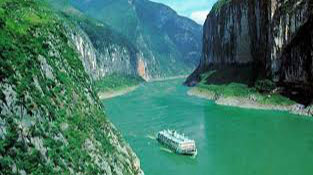China’s high-speed rail is one of the success story on Chinese modernization. It truely reflects China’s strength on technology research and development, innovation, and manufacturing. Since the start of high speed rail construction in 2004, China has made a leap from licensing foreign technology to developing domestic technology. It has completed about 48,000 kilometers of tracks, accounting for more than 70% of the world’s total, and covering over 95% of the cities with a population of more than 500,000. The operating speed of the train is currently running at 350 kilometers per hour, but it will be upgraded to about 450 kilometer per hour with the same design and construction. In the future, a new train will be built based on maglev technology with speed up to 600 kilometer per hour.
Since the high speed train is connecting most of the larger cities, it brings unprecedent economic development to the urban areas. Cities can draw people, land, and other resources within a circle of one hour travelling time. In the future, even more cities can be connected together to form cluster with the 600 kilometers per hour train. China’s high-speed rail has not only improved domestic transportation, but also exported the technology to the world as the “Belt and Road” project. It would contribute more to the development of global transportation.
The whole High Speed Train network has eight north-south routes and eight east-west routes. Here is a brief description of the routes.
Eight north-south routes:
– Coastal corridor: Connects Dalian (Liaoning,大连) to Fangchenggang (Guangxi,防城港), is an important link of the eastern coastal economic zone, and some sections have been built with a speed of 350 kilometers per hour.
– Beijing-Shanghai corridor: China’s first 350-kilometer-per-hour high-speed railway, has been fully connected, and is the main economic artery of the east.
– Beijing-Hong Kong corridor: Some sections such as the Beijing-Xiong’an-Shangqiu (北京-熊庵市-商丘市) high-speed railway are under construction and expected to be opened to traffic in 2026.
– Harbin-Beijing-Hong Kong corridor: (Heilongjiang,哈尔滨-北京-香港) Has been fully completed and runs through the north and south.
– Huhhot-Nanning corridor: (Inner Mongolia,呼和浩特-Guangxi,南宁) Some sections are under construction, such as the Xiangyang (襄阳) to Changde (常德) section, which is scheduled to start construction in 2025.
– Beijing-Kunming corridor: (北京-Yunnan,昆明) Some sections such as the Chongqing-Kunming high-speed railway are under construction, and are scheduled to be opened to traffic in 2027.
– Baotou-Haikou corridor: (Inner Mongolia,包頭-海口) Some sections such as the Xi’an to Yan’an section are scheduled to be completed in 2025.
– Lanzhou-Guangzhou corridor: (Gansu,兰州-Guangdong,广州) Some sections such as Lanzhou to Hezuo are scheduled to open to traffic in 2027.
Eight east-west routes:
– Suifenhe-Manchuria Corridor: (Heilongjiang,绥芬河-Inner Mongolia,满洲) Part of the line has been completed.
– Beijing-Lanzhou Corridor: (北京-Gansu,兰州) Part of the line is under construction, such as the Xi-Yu High-speed Railway.
– Qingdao-Yinchuan Corridor: (Shandong,青岛-Ningxia,银川) Part of the line is under construction.
– Lianyungang-Urumqi Corridor: (Jiangsu,连云港-Xinjiang,乌鲁木齐) Part of the line is under construction, such as the Lan-Xin High-speed Railway.
– Yangtze Jiang Corridor: Shanghai to Chengdu (Sichuan成都), Shanghai-Chongqing-Chengdu High-speed Railway is under construction and is expected to be completed in 2030.
– Shanghai-Kunming Corridor: (上海-Yunnan,昆明) The whole line has been completed.
– Xiamen-Chongqing Corridor: (Fujian,厦门-重庆) Part of the line is under construction, such as the Chongqing-Wanzhou High-speed Railway.
– Guangzhou-Kunming Corridor: (Guangdong,广州-Yunnan,昆明) Part of the line has been completed.




